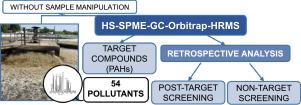当前位置:
X-MOL 学术
›
J. Chromatogr. A
›
论文详情
Our official English website, www.x-mol.net, welcomes your
feedback! (Note: you will need to create a separate account there.)
Assessment of wastewater pollution by gas chromatography and high resolution Orbitrap mass spectrometry.
Journal of Chromatography A ( IF 3.8 ) Pub Date : 2020-02-21 , DOI: 10.1016/j.chroma.2020.460964 Irene Domínguez 1 , Francisco Javier Arrebola 1 , José Luis Martínez Vidal 1 , Antonia Garrido Frenich 1
Journal of Chromatography A ( IF 3.8 ) Pub Date : 2020-02-21 , DOI: 10.1016/j.chroma.2020.460964 Irene Domínguez 1 , Francisco Javier Arrebola 1 , José Luis Martínez Vidal 1 , Antonia Garrido Frenich 1
Affiliation

|
As a novelty, the combination of headspace solid phase microextraction and gas chromatography coupled to an Orbitrap mass analyzer in full scan mode (HS-SPME-GC-Orbitrap-MS) was evaluated for the monitoring of organic pollutants in wastewaters. The developed methodology showed good linearity (R2 > 0.999), sensitivity as well as suitable relative recoveries (89-115%) and precision values (RSD = 1-16%) for 15 polycyclic aromatic hydrocarbons (PAHs) selected as target compounds. Naphthalene, acenapthene and phenanthrene were found in the analyzed samples (influent and effluent wastewaters). Naphthalene was present in 62% of them, ranging from 1.33 to 24.32 ng L-1. Acenapthene was observed in 1 single sample (4.17 ng L-1) while phenanthrene was found in 7 samples (1.51-8.67 ng L-1). In addition, in order to identify other pollutants in the samples, retrospective analyses were addressed through target and non-target screenings. An in-house database containing close to 1,000 pollutants including, among others, polychlorinated biphenyls (PCBs), brominated diphenyl ethers (BDEs) and pesticides, was applied in the post-target analysis. For the non-target screening, after a deconvolution process, high resolution filtering (HRF) and Kovats retention index (KI) were used for tentative analyte identification. Thus, 51 additional pollutants were tentatively identified in the wastewaters, most of them used as flavoring agents and household product ingredients, highlighting the presence of linear alkyl benzenes (LABs).
中文翻译:

通过气相色谱和高分辨率Orbitrap质谱法评估废水污染。
作为一种新颖性,评估了顶空固相微萃取和气相色谱结合全扫描模式Orbitrap质量分析仪(HS-SPME-GC-Orbitrap-MS)的组合,用于监测废水中的有机污染物。对于15种用作目标化合物的多环芳烃(PAH),开发的方法显示出良好的线性(R2> 0.999),灵敏度以及合适的相对回收率(89-115%)和精密度值(RSD = 1-16%)。在分析的样品(进水和出水废水)中发现了萘,cen烯和菲。其中62%为萘,含量范围为1.33至24.32 ng L-1。在1个单一样品(4.17 ng L-1)中观察到粉,而在7个样品(1.51-8.67 ng L-1)中发现了菲。此外,为了识别样品中的其他污染物,回顾性分析通过目标和非目标筛选进行。目标后分析中使用了一个内部数据库,该数据库包含近1,000种污染物,其中包括多氯联苯(PCB),溴化二苯醚(BDE)和农药。对于非目标筛查,在解卷积过程之后,使用高分辨率过滤(HRF)和科瓦兹保留指数(KI)进行试验性分析物鉴定。因此,初步确定了废水中还有51种污染物,其中大多数用作调味剂和家庭产品成分,突出了线性烷基苯(LABs)的存在。多氯联苯(PCBs),溴化二苯醚(BDEs)和农药被用于目标后分析。对于非目标筛查,在解卷积过程之后,使用高分辨率过滤(HRF)和科瓦兹保留指数(KI)进行试验性分析物鉴定。因此,初步确定了废水中还有51种污染物,其中大多数用作调味剂和家庭产品成分,突出了线性烷基苯(LABs)的存在。多氯联苯(PCBs),溴化二苯醚(BDEs)和农药被用于目标后分析。对于非目标筛查,在解卷积过程之后,使用高分辨率过滤(HRF)和科瓦兹保留指数(KI)进行试验性分析物鉴定。因此,初步确定了废水中还有51种污染物,其中大多数用作调味剂和家庭产品成分,突出了线性烷基苯(LABs)的存在。
更新日期:2020-02-21
中文翻译:

通过气相色谱和高分辨率Orbitrap质谱法评估废水污染。
作为一种新颖性,评估了顶空固相微萃取和气相色谱结合全扫描模式Orbitrap质量分析仪(HS-SPME-GC-Orbitrap-MS)的组合,用于监测废水中的有机污染物。对于15种用作目标化合物的多环芳烃(PAH),开发的方法显示出良好的线性(R2> 0.999),灵敏度以及合适的相对回收率(89-115%)和精密度值(RSD = 1-16%)。在分析的样品(进水和出水废水)中发现了萘,cen烯和菲。其中62%为萘,含量范围为1.33至24.32 ng L-1。在1个单一样品(4.17 ng L-1)中观察到粉,而在7个样品(1.51-8.67 ng L-1)中发现了菲。此外,为了识别样品中的其他污染物,回顾性分析通过目标和非目标筛选进行。目标后分析中使用了一个内部数据库,该数据库包含近1,000种污染物,其中包括多氯联苯(PCB),溴化二苯醚(BDE)和农药。对于非目标筛查,在解卷积过程之后,使用高分辨率过滤(HRF)和科瓦兹保留指数(KI)进行试验性分析物鉴定。因此,初步确定了废水中还有51种污染物,其中大多数用作调味剂和家庭产品成分,突出了线性烷基苯(LABs)的存在。多氯联苯(PCBs),溴化二苯醚(BDEs)和农药被用于目标后分析。对于非目标筛查,在解卷积过程之后,使用高分辨率过滤(HRF)和科瓦兹保留指数(KI)进行试验性分析物鉴定。因此,初步确定了废水中还有51种污染物,其中大多数用作调味剂和家庭产品成分,突出了线性烷基苯(LABs)的存在。多氯联苯(PCBs),溴化二苯醚(BDEs)和农药被用于目标后分析。对于非目标筛查,在解卷积过程之后,使用高分辨率过滤(HRF)和科瓦兹保留指数(KI)进行试验性分析物鉴定。因此,初步确定了废水中还有51种污染物,其中大多数用作调味剂和家庭产品成分,突出了线性烷基苯(LABs)的存在。










































 京公网安备 11010802027423号
京公网安备 11010802027423号